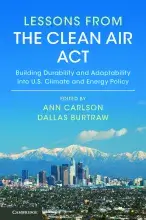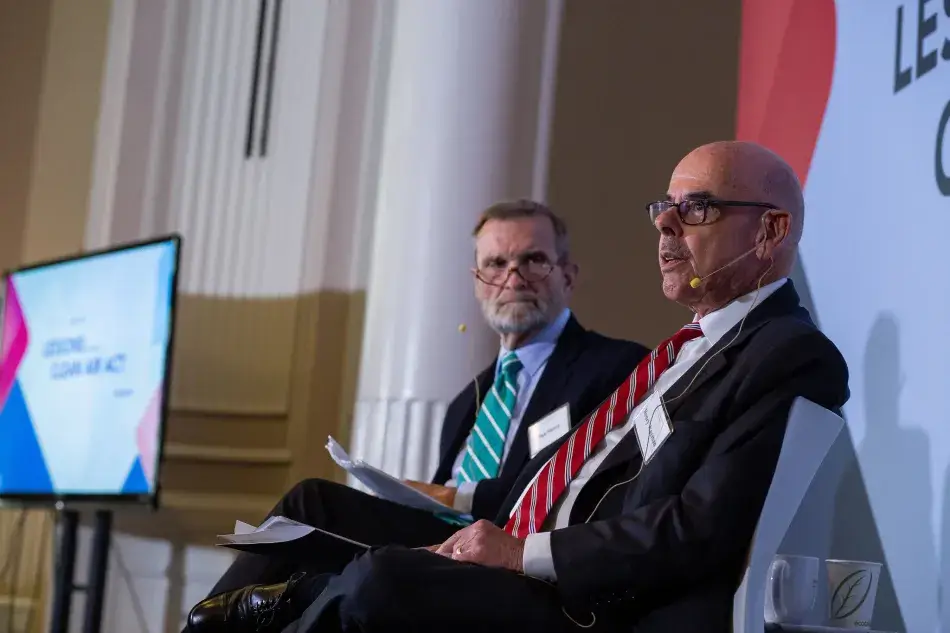I

n September 1955, Los Angeles recorded its worst ozone level ever. At the time, the LA Times reported stories of motorcycle messengers donning surplus WWII gas masks as they moved about the city. The city’s skyline would disappear with the arrival of each September heat. The extreme pollution drove the creation of the Clean Air Act (CAA), first passed by the United States Congress in 1963 and amended in 1970 and 1990. Over five decades, the CAA has become a venerable, living institution that has been highly successful in improving the environment around the country. Its success results from its durability and flexibility, two concepts that often seem to be in opposition yet may be essential to establishing successful climate and energy policy.
A new edited volume from the Academy, Lessons from the Clean Air Act: Building Durability and Adaptability into U.S. Climate and Energy Policy (Cambridge University Press, 2019) examines the Clean Air Act’s successes – and failures – and identifies lessons for improving future climate and energy policy-making in the United States at the federal and state levels. The chapters, authored by seven prominent scholars of climate and energy policy, emphasize how policy solutions will need to be sufficiently durable to produce emissions reductions over the course of decades, long after the end of the political coalition that led to their adoption.
But durability alone will not suffice. Policies will need to be adaptable to new scientific, technological, and economic information. Additionally, to achieve the largest possible reduction in emissions at the lowest possible cost, policy will need to be flexible to allow regulators and regulated entities to meet targets by a variety of approaches, informed by their own knowledge and experience. The contributors to Lessons from the Clean Air Act argue that well-designed policy should reflect and account for all three characteristics simultaneously.
On June 10, 2019, the Academy, in partnership with Resources for the Future, marked the release of Lessons from the Clean Air Act with an event held at the Carnegie Institution for Science in Washington, DC. The book’s editors and contributors discussed how the conclusions presented in the publication could be used to guide the creation of effective energy policies at all levels of government. Ann Carlson (University of California, Los Angeles School of Law), coeditor of Lessons from the Clean Air Act, outlined the importance of durability, adaptability, and flexibility across the five book chapters. She also highlighted an additional attribute of successful policy implementation: independent agency discretion, whereby Congress delegates some authority to an expert agency, such as the Environmental Protection Agency, to allow a policy to be regularly updated without the need for new legislation. Such agency discretion underpins the adaptability and flexibility that is a critical part of the CAA’s success.

Coeditor Dallas Burtraw (Resources for the Future) stressed the important role of regulatory process in agency discretion, saying, “it is not so important to legislate a number as it is to legislate a process” for developing new policies. Future climate and energy policy will need to be updated periodically to account for new technologies, unanticipated effects of global warming, or unexpected success in bringing down emissions. While it might be politically necessary to set a specific numerical emissions target through legislation, any such number may become irrelevant over time, as happened with sulfur dioxide (SO2) cap and trade targets under the Clean Air Act.
Book contributor Barry Rabe (University of Michigan) spoke about the role of federalism in the durability and adaptability of tailpipe emissions standards under the CAA. Most notably, the state of California has the exclusive ability to apply for waivers that allow the state to establish emissions standards that are stricter than federal regulations. Even though the federal government maintains regulatory authority that preempts policies enacted by all other states, California’s large share of the automobile market gives it the power to drive emissions reductions faster than might be possible without the waiver program. For future climate policy, the California waivers could provide a model whereby federal policy imposes some form of preemption on a national basis yet provides a leveraged role for a state to push beyond federal standards.
Former U.S. Congressmen Henry Waxman and Phil Sharp recounted stories of amending the Clean Air Act and failed attempts to pass comprehensive climate legislation. Waxman stated that the 1990 Amendments were only designed to cover a period of approximately ten years, with the assumption that they would be amended again within that timeframe. He endorsed the idea of delegating authority to an expert agency but cautioned that making decisions at the legislative level requires bringing allies onboard, including both Democrats and Republicans. Waxman said, “the key is changing the political dynamic, and until that happens all the good and creative ideas in the world won’t make much of a difference.”
The final session of the event was a panel discussion moderated by book contributor Joseph E. Aldy (Harvard Kennedy School) and it included climate and energy policy experts Jonathan Z. Cannon (University of Virginia School of Law), Megan Ceronsky (Center for Applied Environmental Law and Policy), Jeffrey Holm-stead (Bracewell LLP), and Vickie Patton (Environmental Defense Fund). Patton explained how changes to the Clean Air Act came about in part through action made possible by the rule of law, including both citizen and state lawsuits. Such mechanisms have been essential to the success of the Clean Air Act and will be a critical component of any future climate policy. Aldy responded to the idea of agency delegation by noting that a central climate policy proposal is a carbon tax, and that tax policy is entirely legislatively driven. Additionally, it is unclear how the implementation of a comprehensive carbon pricing regime, such as a carbon tax, would be divided between the Treasury Department, the Internal Revenue Service, and the Environmental Protection Agency. Holmstead countered that the costs of implementing the CAA have been too high, and that in the future industry will not support legislation that delegates significant authority to the Environmental Protection Agency.
Lessons from the Clean Air Act is the final publication from the Academy’s Alternative Energy Future project, cochaired by Academy members Maxine Savitz (Honeywell, Inc, retired) and Granger Morgan (Carnegie Mellon University). The project has examined the legal, social, and economic factors that can either inhibit or facilitate transformative change in the U.S. energy system. Beginning with the 2011 Academy report Beyond Technology: Strengthening Energy Policy Through Social Science, and continuing with the publication of two Dædalus issues and workshops co-organized with the U.S. Department of Energy and the New York State Energy Research and Development Authority (NYSERDA), the Alternative Energy Future project has highlighted the value of social and behavioral sciences for developing effective energy policy and programs, and recommended strategies for enhancing collaboration between scholars and policy-makers.
Lessons from the Clean Air Act: Building Durability and Adaptability into U.S. Climate and Energy Policy was made possible by the Alfred P. Sloan Foundation, which supported the research with generous funding. Additionally, the Kresge Foundation funded a series of workshops that allowed for review of the book’s conclusions by scholars and state and local policy-makers. The book is available for purchase from Cambridge University Press, and an executive summary is available from the Academy.